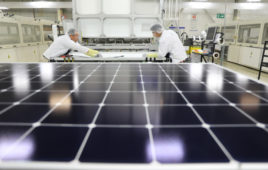 When the solar industry consisted of a sprinkling of residential sites in California, monitoring them didn’t seem essential.
When the solar industry consisted of a sprinkling of residential sites in California, monitoring them didn’t seem essential.
Inverter manufacturers embedded systems to audit the performance of their products, but thanks to limitations in technology, the information wasn’t instantaneous. Additionally, most users were homeowners, who had neither the time nor the expertise to evaluate the data.
Since then, the solar industry has become the second-fastest growing energy source in the United States. It achieved 76% growth in 2012, according to GTM Research and the Solar Energy Industries Association (SEIA). These days, monitoring a system’s performance is quickly becoming less of an add-on, and more of a requirement.
The instantaneous transfer of information has radically changed the way the solar industry functions. After all, underperforming systems put the entire industry’s reputation at risk.
“A few years ago, most solar resources were owned and maintained by the end-user,” says Richard Duong, product engineer for Moxa Americas in Brea, Calif. “Now they’re being operated by companies who are owned by banks. Monitoring is absolutely critical in that scenario so companies and investors can make sure they are remaining profitable.”
Data Dump
Until recently, most monitoring applications were designed to capture data from various solar-power-system components at regular, fixed intervals, Duong says. Then the information would be delivered, downloaded on a computer and set aside for analysis at a later time.
“That’s kind of the way it went when we first entered the market,” Duong says. “People weren’t able to analyze the data immediately, and it became outdated quickly. What started as pure dataloggers are now becoming mini energy-management servers. No matter what computing platform you use, it has to be robust enough not to just gather information, but put it in context so people can use it.”
 According to Adrian De Luca, VP of sales and marketing for Locus Energy, there are three types of monitoring systems in the market right now:
According to Adrian De Luca, VP of sales and marketing for Locus Energy, there are three types of monitoring systems in the market right now:
• Inverter manufacturers typically sell inverter-based monitoring as an add-on. These are designed to provide basic transparency into inverter performance and generally do not have robust fleet-management tools. In other words, the hardware and software are designed to highlight individual PV system generation data, but are not ideal for managing larger groups of systems.
• Proprietary monitoring systems are developed by solar-service providers and are only offered as part of a third-party ownership agreement. SolarCity and SunEdison are good examples. As two of the first providers of third-party owned solar systems, both companies created their own monitoring platforms because there were few off-the-shelf monitoring solutions available as they launched. Generally, proprietary systems are full-featured, but are not available outside of their lease/PPA agreements.
• Independent monitoring systems are provided by companies that market solutions independent of OEMs and financing groups. These are typically the most full-featured platforms because the vendors focus all of their resources on building the best monitoring hardware and software. These solutions include a broad range of O&M tools for solar fleet operators as well as customized interfaces for end-users.
Real-time monitoring has value even before a project is commissioned, says Robert Schaefer, president and CEO of Also Energy in Boulder, Colo. Computer models allow the engineering, procurement and construction companies (EPCs) to test the arrays before they are commissioned. After they’re put into service, operations-and-maintenance (O&M) companies can monitor the sites to make sure they continue to perform at promised levels.
It would be easy to get overwhelmed by the amount of information today’s monitoring systems provide, but Schaefer says today’s systems also have alert protocols that pare it to the essentials.
“At some point, you need to rely on a robust alert system to let you know when something has gone wrong on your site,” Schaefer says. “No one can monitor 1,000 sites. It’s just too much. If you can get specific alerts only when there’s something going wrong with the site, it becomes far more manageable.”
Make The Investment
Locus Energy’s De Luca argues the people monitoring systems have changed over the years. No longer is the actual end-user getting day-to-day information about how their system is performing.
“In today’s market, people are not purchasing hard goods,” De Luca says. “They’re buying a service, so they no longer have a day-to-day vested interest in their system’s performance. That’s one of the things they pay their service providers to do. It’s the integrators, installers and O&M companies who are monitoring the systems to make sure they’re delivering the amount of power dictated in the agreement.”
De Luca refers to leasing companies like SolarCity, Sunrun, Constellation Energy and One Roof as fleet managers. They have thousands of systems to track, and that’s how they make money. If fleet managers don’t monitor these systems, they risk rapid financial failure.
“For the end-user, monitoring is both a means of confirming that his solar-service provider is delivering power within the guidelines of the contract and a platform to demonstrate to friends and family the benefits of going solar,” De Luca says. “This last point can’t be overlooked. The cost of customer acquisition is high, making word of mouth and customer referrals key lead generators for service providers.”
Monitoring provides such detailed information that it could potentially increase projects’ bankability, Also Energy’s Schaefer says. After all, you can’t manage what you don’t measure, and monitoring gives investors an increased sense of security because they can see their investments working.
“Financiers and operations-and-maintenance companies want to evaluate their systems, wherever they are, and make sure they’re performing as promised,” Schaefer says. “They can’t afford to have underperforming projects because they have committed to producing certain levels of electricity. Failure to produce those levels could be financially catastrophic.”
Protecting The Industry
Moxa’s Duong says one of the biggest issues facing monitoring manufacturers is how to secure the data during transmission.
“As solar arrays become more popular inside communities, the power grid is going to need to control the inverters,” Duong says. “Once you open up these inverters to external control, the networks must be safe and secure. Think of it this way: We all have our bank accounts online, and that’s considered one of the most secure things around. The solar industry is moving toward more secure information while still allowing the critical analysis by the companies to happen.”
And whether the solar industry likes it or not, it is under intense scrutiny by solar-power skeptics, so monitoring and managing solar projects effectively becomes critical.
“Investors are making this industry go forward by putting up the money for these projects,” Also Energy’s Schaeffer says. “The last thing you want to do is give an investor a bad experience because solar is competing with every other investment opportunity in the world. We can’t afford not to deliver.”




Tell Us What You Think!